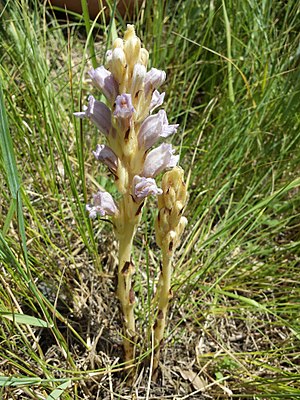Sand summer root
| Sand summer root | ||||||||||||
|---|---|---|---|---|---|---|---|---|---|---|---|---|

Sand arum ( Orobanche arenaria ) |
||||||||||||
| Systematics | ||||||||||||
|
||||||||||||
| Scientific name | ||||||||||||
| Orobanche arenaria | ||||||||||||
| L. |
The sand-broomrape ( Orobanche arenaria ), also called sand Würger is a species of the genus of orobanche ( Orobanche ) in the family of broomrape plants (Orobanchaceae).
description
The sand summer root is a perennial herbaceous plant . It is a chlorophyll- free root parasite . The sand summer root reaches heights of 15 to 40 centimeters. Their strongly scaled stalk is usually simple and hairy with glands.
15 to 40 flowers are clustered together in a 20 to 30 millimeter long, racemose inflorescence . The hermaphrodite flowers are zygomorphic with a double flower envelope . The calyx is bell-shaped, four-toothed, surrounded by three bracts (a bract and two bracts). The petals are light purple-blue. The anthers are woolly and long hairy and the stigma is whitish.
The number of chromosomes is 2n = 24.
ecology
The sand arum is a perennial, presumably only once blooming geophyte and a parasite without leaf green . The sand arum extracts water, minerals and organic substances from its host plant , so that it lags behind in its development and does not bloom.
The sand summer root forms flowers that are pollinated by bees and bumblebees . Thousands of very small and light seeds then form in each fruit capsule and are spread with the wind. To germinate , the seeds need contact with the roots of a host plant again. To do that, they emit chemical irritants.
Occurrence and endangerment
The distribution area of the sand arens extends from the Atlantic coast of Portugal in the west over Spain, southern and central France, northern Italy to the Caucasus, Urals and Aral Sea in the east; in the northeast it extends to about 54 ° north latitude and in the south from North Africa to the Middle East (Iraq, Iran).
The sand summer root is rare in Central Europe. They are found in Central Europe in limestone and sandy grasslands, on warm, dry, base-rich, loose sand and loess soils . It parasits on sagebrush ( Artemisia campestris ) and more rarely on common mugwort ( Artemisia vulgaris ). It occurs in Central Europe in plant communities of the Sedo-Scleranthetea and Festuco-Brometea classes.
Danger
In Germany, the sand summer root occurred earlier in all federal states except Schleswig-Holstein (with Hamburg), Lower Saxony (with Bremen) and the Saarland. This species is "extinct" in North Rhine-Westphalia, Berlin and Saxony. The summer root in Mecklenburg-Western Pomerania, Brandenburg and Saxony-Anhalt is “threatened with extinction” ( Red List - Category 1); in all other federal states it is "severely threatened" (RL 2).
Individual evidence
- ↑ a b Erich Oberdorfer : Plant-sociological excursion flora for Germany and neighboring areas . With the collaboration of Angelika Schwabe and Theo Müller. 8th, heavily revised and expanded edition. Eugen Ulmer, Stuttgart (Hohenheim) 2001, ISBN 3-8001-3131-5 , pp. 865 .
Web links
- Orobanche arenaria Borkh., Sand-summer root. In: FloraWeb.de.
- Sand summer root . In: BiolFlor, the database of biological-ecological characteristics of the flora of Germany.
- Profile and distribution map for Bavaria . In: Botanical Information Hub of Bavaria .
- Orobanche arenaria Borkh. In: Info Flora , the national data and information center for Swiss flora . Retrieved March 23, 2016.
- Thomas Meyer: Blauwürger data sheet with identification key and photos at Flora-de: Flora von Deutschland (old name of the website: Flowers in Swabia ).
- Description from the Morbach Environment Working Group - rhein-Zeitung .


